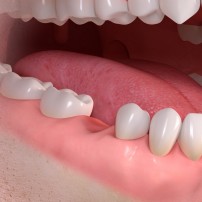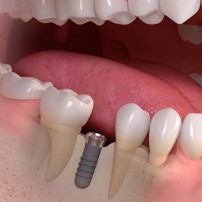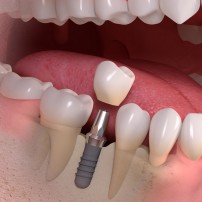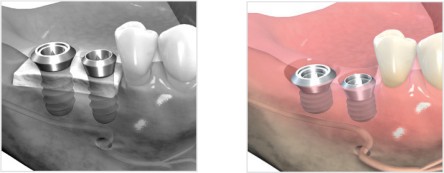Dental Implants are essentially titanium screw threaded components that are placed into your jaw bone to replace a root of a tooth. Occasionally they will be made out of other materials.
The implant, once placed, often requires some additional bone adding (a graft) around it in order to ensure its long term stability and an aesthetic result.
In order to access the bone where the implant is to be placed, once the area is numb (with local anaesthetic) the gum is cut and a flap of it is raised and held out of the way whilst the implant is placed into the bone.
The implant can be placed at the same time as tooth removal or around 3 months afterwards. Obviously if your tooth is already missing then this time scale will change
Once an implant is placed, the gum is either sutured (stitched) to cover over the implant completely or a healing cap is placed and the gum sutured around it.
Very occasionally dentists may place a crown (the part of the implant restoration above the gum level) on the implant immediately (known as immediate loading) but although this may be desired from an aesthetic point of view and reduced number of visits; It may put too much force onto the implant in the early stages when the implant should be integrating with the bone surrounding it and may lead to early failure.
Usually, therefore, an implant is usually left for a minimum of 2-3 months to integrate with the bone surrounding it. Sometimes, in cases where a lot of bone has been grafted onto the implant site it should be left for 6 months or longer before placing the final restoration.
In this interim period, a temporary restoration is usually placed if desired. Back (posterior) teeth may not require a temporary tooth. The temporary will usually be either
1. Conventional denture
2. Conventional Resin bonded bridge (which is a false tooth with one or two metal wings attached to it that bond to the teeth next to the implant
3. Composite resin bridge (which may be made freehand from white filling material and bonded to the teeth next to the implant)
1. Conventional denture
2. Conventional Resin bonded bridge (which is a false tooth with one or two metal wings attached to it that bond to the teeth next to the implant
3. Composite resin bridge (which may be made freehand from white filling material and bonded to the teeth next to the implant)
The Next Stage
Your dentist may need to uncover your implants (if they were covered over completely with gum at the surgical implant placement stage) and then healing caps placed on the implants and the gum sutured around this. This needs to be left another month or so to allow accurate impressions of the implant and site to be taken at the next visit.
Sometimes your dentist will place different healing caps at this stage in order for the surrounding tissues to form the correct gum shape to give the most aesthetic final result and so a couple of additional short appointments may be required.
Impressions stage
This will either take place at the first appointment after the 3 or more months of implant integration or after the stage above.
The healing caps are removed and other inserts placed into the implants. Impressions (moulds) of the implant and surrounding tissues are taken and sent to the lab so as they can produce the final or a provisional restoration (crown, bridge or denture)
Your temporary restoration will then be replaced along with the healing caps for as long as it takes to make your crown/bridge (usually around 2 weeks)
After Impressions
In the case of simple crowns and bridges supported by implants these may be made straight away and then fitted at this appointment! about 2 weeks or so after the impressions appointment
If a lot of teeth are being replaced with crowns, bridges or dentures on multiple implants then 2 or 3 additional appointments are required where your dentist will record the positions of your jaws relative to each-other and try in the different restorations before getting them finished and fitted.
The Fit Appointment for Crowns and Bridges
At this appointment any temporary crowns or bridges are removed or the healing caps/covers are unscrewed from the implant. The part that connects the implant to the final restoration (the abutment) is attached to the implant which will then resemble the shape of a prepared tooth.
The final crown or bridge can now be either cemented or screwed onto the implant abutment. If a screw retained restoration is used, the screw hole is filled with filling material so you are not left with a dip in the restoration.
Any excess cement is cleaned, the tooth contacts with adjacent teeth and opposing teeth are checked to ensure everything as fine and appearance is checked
Screw retained vs cemented restorations
Some restorations (crowns and bridges) will be screwed into place rather than cemented. This is being done more and more often nowadays as it removes the need for cement which can degrade over time or remain deep in the gum after fitting the restorations and cause your gums to become inflamed (red and sore). The entry hole for the screw on front teeth is from the back of the tooth so it is hidden and from the biting (occlusal) surface on back teeth. The screw hole is then covered with filling material.
The Fit Appointment for implant supported dentures
As before, any temporary denture or healing caps are removed, implant abutments are attached to the implants and the denture is fitted into place. How your denture looks and how you bite together is then rechecked.
The denture will then be screwed into place if it is screw retained. In some cases rather than screws; ball and socket attachments,bar attachments, magnets or friction grip is used to retain the denture (keep the denture in place). In case of these, the denture is pushed into place and then you will be shown how to take the denture in and out if it is a removable one.
Important points to note/expect
- You will be sore, bruised and swollen after implant placement as it is a surgical procedure
- This procedure cannot be rushed, if your dentist thinks the implant is best left for 6 months or more before restoring it then this is because it is in your best long term interests.
- If you need extra appointments before fitting the final restoration in order to shape the gum, this again is to ensure the best final aesthetic result possible
- In some cases an ideal result may not be possible due to the extent of bone loss or condition of surrounding teeth. You must understand the limitations in your case before you commence treatment so you fully know what to expect
- You may have to wear a temporary removable denture for a number of months before your final restorations are fitted
- At the fit appointment the gum may blanch (go white) around the restoration but this is normal and it will go back to normal colour quickly.
Dental Implant cost
We will discuss implant cost further in the next article on dental implants but as a general guide the implant itself will cost you between £1100 and £1600. The Crown and abutment on top will cost between £700 and £1500per tooth and then if you require a bone graft as well it will cost between £250 and £600. Therefore typically all in costs will start from £2200 and £3800
We hope this has been useful for you for what to expect when it comes to your implants. The next articles in this series will discuss different types of implant and implant restorations as well as the fees involved and how the latest research applies to you...the patients!




 RSS Feed
RSS Feed